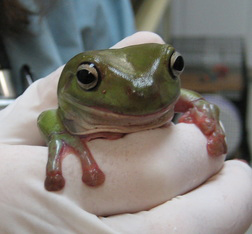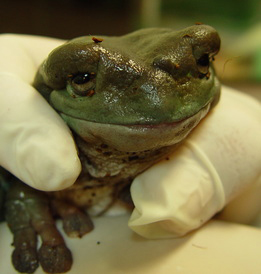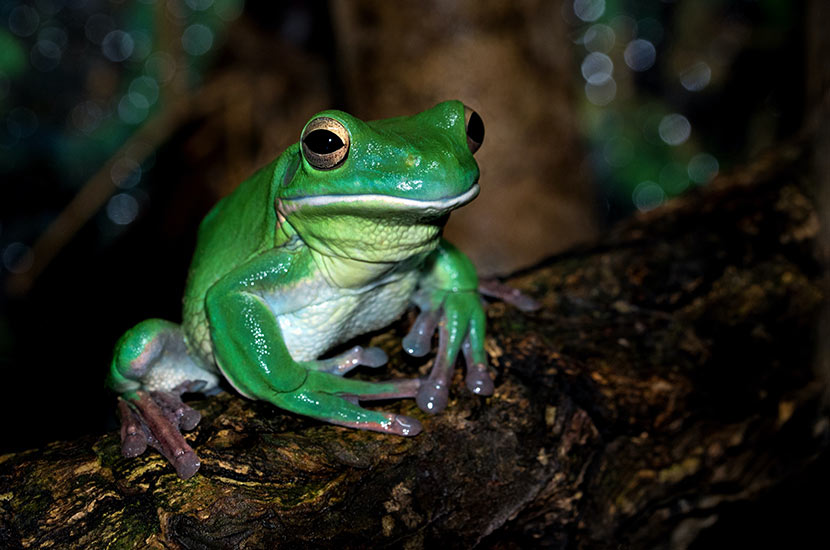by Teresa Bradley, DVM, Kevin Wright, DVM
Caging
 A tall or high (15-20gal) aquarium is recommended for housing one adult frog. Larger enclosures are needed for additional frogs, not to exceed five adults frog in 100cm x 50cm x 50cm(40 in x 19 in x 19 in) enclosure.
A tall or high (15-20gal) aquarium is recommended for housing one adult frog. Larger enclosures are needed for additional frogs, not to exceed five adults frog in 100cm x 50cm x 50cm(40 in x 19 in x 19 in) enclosure.- Perches should be as wide as the frog’s body and placed primarily in a horizontal position. If diagonally inclined perches are utilized, they should be placed at only slight angles to decrease difficulty of climbing for the larger, heavier frogs.
- Although not necessary, plants with stout branches and leaves may be provided (snake plants, Sansevieria spp., or philodendron, Monstera spp.) Avoid use of silk plants.
- Substrates may include brown paper towels, butcher paper, or “carpet” type artificial grass with sealed edges.
- Chlorine and chloramine-free water should be used in the water bowl and for misting the frogs each evening.
- A tight-fitting screen top with a locking mechanism is necessary to provide adequate ventilation and prevent escapes.
- The enclosure temperature in the daytime should range from 24-29°C (76-85ºF) with basking area that does not exceed 32ºC (90ºF). Nighttime temperature should not fall below 18ºC (65ºF).
- A 12 hour day and 12 hour night cycle should be provided. A pure red incandescent bulb or a thermostatically controlled, under the tank heating pad may be used to heat the enclosure at night.
- Ultraviolet-B emitting bulbs should be used such as Reptisun 5-0 bulb.
Water
- Use chlorine- and chloramines-free water such as bottled spring water, charcoal-filtered tap water or tap water that has been aerated for at least 48 hours.
- Provide water at all times. The depth should be less than the height of the tree frog resting with its legs folded.
- Place small rocks or other ramps in the water to prevent drowning of the frogs or prey items.
- Clean water bowls daily or provide filtration.
- Slightly alkaline, moderately hard water is recommended. Guidelines for freshwater cichlids (a type of tropical fish) are acceptable.
Diet
 Froglets up to four centimeters (one and a half inches) may be fed one to four pinhead crickets, daily. If few or no crickets remain in the enclosure within 30 minutes of feeding, add a few more crickets at the next feeding.
Froglets up to four centimeters (one and a half inches) may be fed one to four pinhead crickets, daily. If few or no crickets remain in the enclosure within 30 minutes of feeding, add a few more crickets at the next feeding.- Sub adult frogs up to eight centimeters (three inches) may be fed one to two, three to four week old crickets, two to three times each week. Once a month the crickets may be replaced with small earthworms or one pinky mouse. If few or no crickets remain in the enclosure within 30 minutes of feeding, include a few more crickets at the next feeding.
- Adult White’s tree frogs may be fed three to four adult (large) crickets twice weekly. Once each month large earthworms, night crawlers or one fuzzy mouse may be fed instead of crickets.
- Crickets should be fed a gut-loading diet (commercially prepared cricket diets that contain at least eight percent calcium) for 48 hours prior to being used as a food source. Dust cricket with a calcium carbonate powder (oyster shell or cuttlebone) three to four times weekly. At least one feeding each week should include crickets dusted lightly with a multi-vitamin-mineral mix recommended by your veterinarian. Feed the dusted crickets to the frogs immediately after dusting.
- Dusted prey items should be offered in the early evening when the frogs are active, to ensure that the food is found and consumed within 60 minutes.
Medical Problems
Amphibians may become very ill quickly if they do not receive prompt medical attention. You should consult with your veterinarian if any of the following problems are noted with your White’s tree frog:
- loose stools
- little or no stool production
- weight loss
- poor appetite
- listlessness or inactivity in a normally active frog
- cloudy eyes
- reddish discoloration of the belly skin or legs
- swelling on the head, body or legs
- swollen abdomen
- difficulty breathing
If you have any questions, please feel free to call us at (502) 241-4117.

